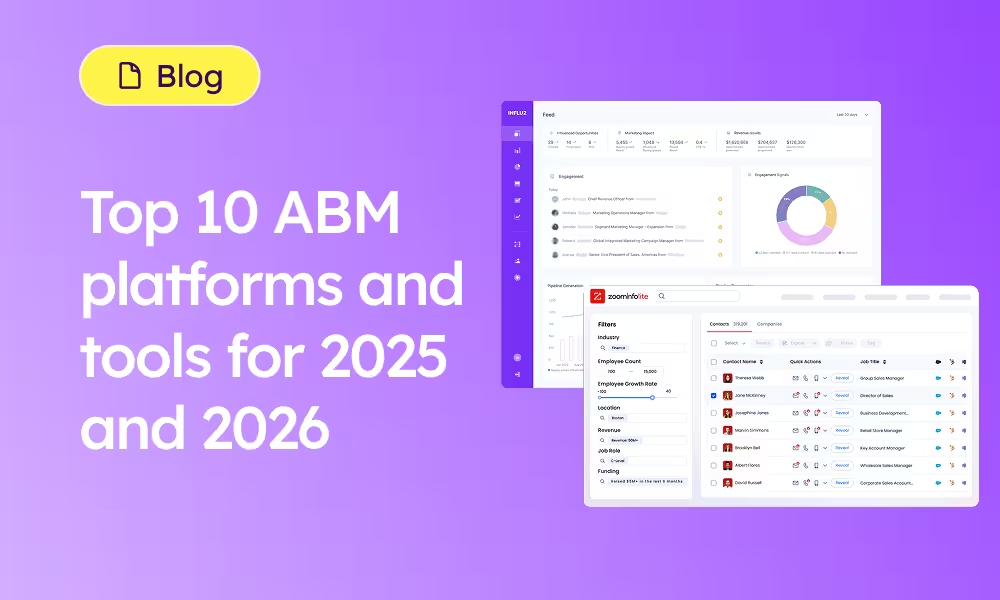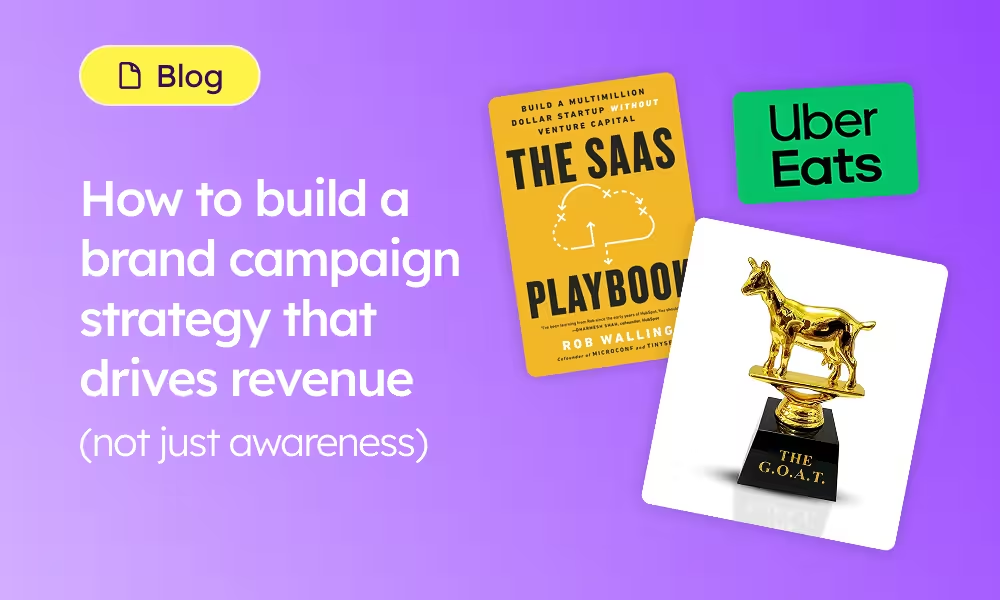One powerful platform for ROI-driven corporate gifting, swag, and engagement at scale.
The B2B marketing landscape has been flooded with changes over the last few years – leaving many go-to-market (GTM) teams feeling stranded and without a paddle.
In a volatile economy, efficiency is the buzzword du jour. GTM teams are under pressure to parlay smaller budgets into bigger results – despite the fact that sizable chunks of their target audience are tightening their purse strings, too.
Meanwhile, a crowded digital market and the rise of informed, discerning consumers are making it harder to stand out and establish conversations – let alone take buyers all the way through the funnel. Without high-quality opportunities to pursue, sales pipelines (and the GTM teams trying to fill them) are becoming exhausted.
One thing's for certain: the rigid strategies and team structures that may have worked in the past are no longer sustainable. Siloed GTM teams and one-size-fits-all customer experiences are leading to a plethora of problems, which may sound all-too familiar…
Break the mold with allbound engagement
It's not all doom and gloom. Allbound engagement is a lifeline for struggling pipelines as it treats inbound and outbound as one powerful motion. This strategy promotes a different kind of efficiency by unifying your sales, marketing, customer success, revenue operations and partnerships teams so they can focus on working toward their shared goals.
Whether your current pipeline is looking a bit depleted or you want to sharpen your competitive edge, you can use the allbound engagement methodology to identify key moments in your buyer’s journey that can be optimized to drive better business results.
The most successful B2B marketing teams of tomorrow will be those that base their decisions on clear and transparent data. According to a 2023 study by Gartner, 65% of B2B sales organizations will transition from intuition-based to data-driven strategies by 2026.
Allbound engagement encourages GTM teams to work from the same dashboards and have regular touchpoints. This gives your inbound and outbound functions a 360° view of each other’s workflows and responsibilities, dramatically improving alignment so they can tackle pipeline problems with more precision than ever before.
Triumph in the age of the customer
Finding the right audience, capturing their interest, and converting them into qualified opportunities has always been a challenge, albeit the kind that passionate GTM teams enjoy and thrive on. But a saturated digital marketplace is making their jobs harder than ever.
While competition has never been tougher, B2B buyers have never been so well-informed. Under the careful instruction of watchful CFOs, the decision makers that GTM teams are targeting now demand clear evidence of ROI before even considering an investment.
This has put extra pressure on sales and marketing to somehow pierce through the noise with messaging that demonstrates their product’s contributions to the bottom line.
Another factor that’s causing stress for GTM teams is that today’s B2B customers are prone to jumping ship, seemingly on a whim. Although the current economic climate isn’t ideal, these decisions are rarely determined by the allure of cost savings, at least completely anyway.
It’s true that budgets are being cut across the board, but there are some things that companies don’t want to compromise on, and excellent customer service is one of them. According to a 2022 study, 58% of customers will gladly pay more to avoid poor service down the line.
Instead, the competitors who are snapping up the accounts you’re working so hard to woo are those that have successfully differentiated themselves from you and created a smooth customer experience that generates organic word of mouth.
Throw your pipeline a lifeline
Every business transformation starts with asking some important questions.
When addressing the problems leading to low pipeline, it’s important to consider a variety of factors and how they impact your business in order to create the most tailored and effective solution possible.
1. What are your pipeline measurement metrics?
As a unit, your GTM team is essentially responsible for opening and closing pipeline (before Customer Success steps in to drive renewals).
Preparing a shared list of metrics to measure pipeline performance is therefore integral to making better decisions about your strategy as a team.
Here are some useful questions to ask before starting your allbound journey…
- What inbound and outbound channels and tactics are you currently using?
- How efficient are these channels and tactics?
- How is each team contributing to pipeline growth? Which initiatives are driving this success?
- What is sales self-generating and can you see influence from other initiatives?
- What is the average deal size for both sales and marketing?
- How many times were each opportunity generated touched by marketing and sales?
- How are you collectively working together towards pipeline goals?
2. What’s your pipeline velocity?
Accelerating your sales pipeline will be one of your main goals with allbound engagement, so pipeline velocity is a key metric to watch.
Knowing your pipeline velocity helps you increase the revenue flow into your business every day and allows you to make timely adjustments. Here are a few questions to get you started…
- What is your win rate? Which initiatives contributed to this?
- What are the conversion rates and closed won rates?
- Where are we losing them post-opportunity creation?
- What are we losing to competition?
- How many qualified opportunities do you generate?
- What is your average deal value?
- What is the average sales cycle length?
Make better use of the data you have
Of course, an aligned strategy between inbound and outbound hinges on having access to transparent data. That’s where your revenue operations team comes in.
The role of RevOps is to provide a single source of truth on revenue impacts shared between sales, marketing, customer success and finance. Ensuring that they are part of your GTM initiatives will allow information to flow both from the top down and the bottom up, giving everyone full visibility and bolstering the strength of your allbound engagement strategy.
If your company doesn’t have an RevOps team, or operations personnel reporting into different lines of business, then each head of department within your GTM team should take ownership of their data.
Working from shared project dashboards will help keep the GTM function aligned and informed, but they should also be meeting on a weekly or at minimum a monthly basis to share their data-backed learnings as well as any ideas they have to modify and optimize their strategy.
Energize your teams and bring them together
Your GTM teams likely know that the strategic initiatives they’re currently working towards aren’t as efficient as they could be, and are draining them of precious time, energy, and resources.
But until a viable alternative presents itself and senior leadership put their full weight behind a new direction, the GTM show must go on, and the vicious cycle of reactive – rather than proactive – workflows will continue.
As you might’ve gathered by now, adopting an allbound engagement lens basically means ensuring all your teams feel aligned, encouraged to be honest about what’s holding them back, and involved in any decisions to optimize processes moving forward.
When looking at why you're losing to competitors, you’ll need your team’s help to identify where in the customer journey you’re seeing the biggest drop-off in engagement. Which teams are involved? How closely are they collaborating?
When tackling wasted time and energy, you’ll need to give all your teams the opportunity to share which processes they believe are slowing them down, and make sure they feel comfortable doing so.
How to unite your teams
Here are a few pointers to help you create a happier and healthier GTM team.
Introduce new touch points
Put regular cross-functional meetings into everyone’s calendar. Instead of going through the usual to-do list, this is a chance for team members to proactively share performance data and the lessons they’ve from them, in addition to giving cross GTM members an opportunity to gain deeper understanding and raise questions that would have otherwise gone unasked.
Spearhead shared dashboards
Make sure your teams are working from the same dashboards and reports in your CRM platform, such as HubSpot, Salesforce or whatever tool you use.
Clarify shared goals
Once you’ve chosen which metrics you’ll be using to define success, communicate these clearly across your GTM teams. Identify data that can be used to drive joint strategies. Set key performance indicators (KPIs) for the team and track them in shared platforms such as Asana or Trello.
Combine buyer journey knowledge
Each of your teams contribute to the buyer journey in a different way. They should feel able to share their insights from the different stages across the GTM team, which should then be incorporated into all strategies and content moving forward to create a consistent customer journey.
Cross-team training
Encourage your teams to train each other in topics and skills they can all benefit from. For example:
- Marketing could educate Sales on the campaign experiences their accounts go through before getting to sales.
- Sales could educate Marketing on the stickiest points and or personas within the sales cycle.
- Demand Generation could educate RevOps on the account scoring models they use to prioritize and qualify accounts, which RevOps can adopt to ensure that Sales and Marketing are together focused on high-quality accounts.
- Partnerships could educate Content on the company’s different customer bases, so they can produce tailored content that clicks with each audience.
- Customer Success could pass their account management skills on to Partnerships to help them manage their own partnership relationships more effectively.
- RevOps could educate all GTM teams on how to implement data hygiene practices to improve the quality of their contact and account databases and customer information.
Wrapping up
If any of the challenges we’ve addressed here sound all-too familiar, allbound engagement could be the antidote you need to optimize your strategies and generate pipeline. Equipped with better alignment and powerful data, your go-to-market teams can go further than ever before.
Ready to start your allbound journey? Download our playbook to learn more about allbound engagement, the many challenges it can solve, how to measure success, and much more!









